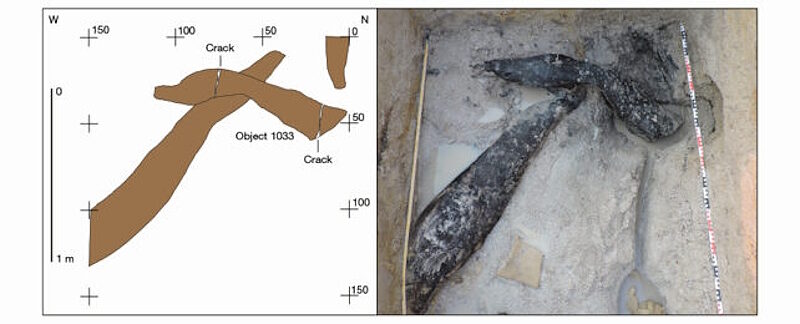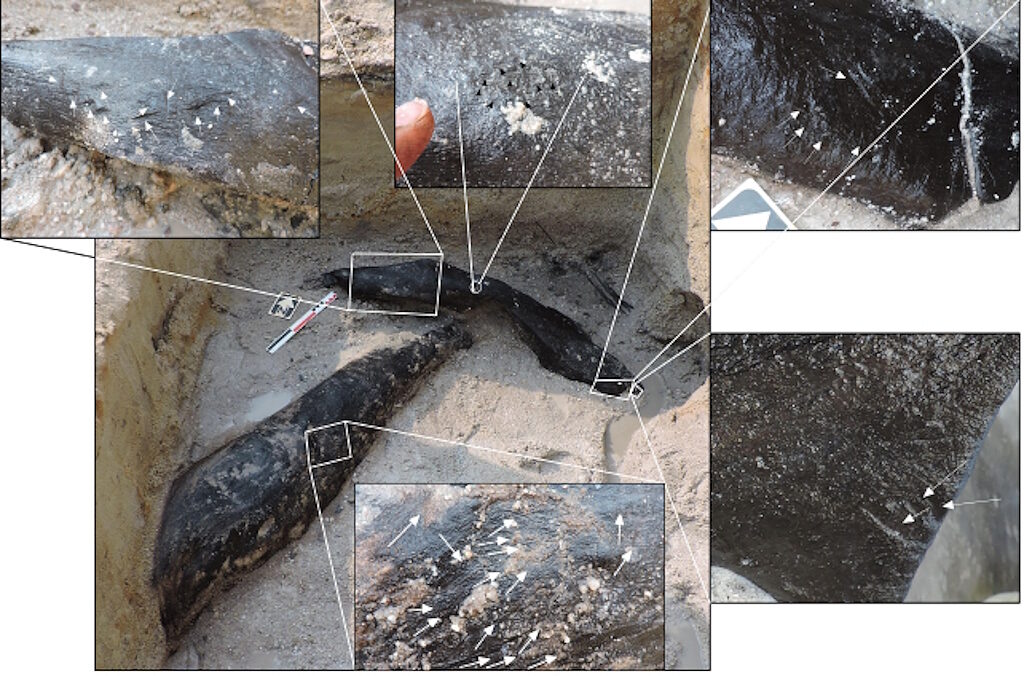
Uncovered in 2019 at the Kalambo Falls in Zambia, the objects provide archaeologists with an exceptionally rare look at wooden technology from mid-Paleolithic Africa, a time better known for an acceleration in the innovations of stone tools. The logs also predate the evolution of our own species, Homo sapiens.
An analysis conducted by an international team of researchers has now come to the astonishing conclusion that the wooden artifacts were once part of a permanent structure of some kind, such as a platform or building.
If so, the discovery complicates the conventional image of hominins as nomads hunting migrating herds or gathering seasonal flora with relatively basic tools.

"Forget the label 'Stone Age,' look at what these people were doing: they made something new, and large, from wood. They used their intelligence, imagination, and skills to create something they'd never seen before, something that had never previously existed."
While indirect signs of woodworking by mid-Pleistocene hominins can be found in the form of plant residue or patterns of wear on stone tools, Stone Age items carved from timber rarely survive the ages.

In Africa, time wears away traces of handiwork far too readily, leaving few examples of intentionally shaped objects. Those rare examples are typically salvaged from sites with the right conditions for preserving plant materials over tens to hundreds of thousands of years.
Kalambo Falls is just such a place. Situated above a majestic 221 meter (725 foot)-high waterfall a short distance from the Kalambo River, the site saw regular flooding that deposited layers of sediment, trapping and preserving traces of archaeology between its watery layers like pressed flowers in a book.
In the mid-20th century, excavations at the site recovered notched wooden items suspected to have been carved by human hands. Dating methods suggested the items were at least 110 thousand years old, with hints that they could be far older.
As remarkable as the objects are, few would have expected to dredge up the remains of two logs modified to lock into some form of structure.
Each of the items appears to be made from a medium-sized species of bushwillow native to the African savannah, with signs of chopping, scraping, and possibly burning around what is presumed to be an intentionally-carved notch.
The two logs, each more than a meter in length, taper to a point with clear signs of scratching and shaping.
While it's impossible to determine the purpose of the interlocking sections, viewed in association with other discoveries at the site, including several other small wooden artifacts and stone implements, the authors tentatively interpret the findings as structural.
To determine when the items may have been crafted, the researchers applied a version of infrared stimulated luminescence dating to determine when minerals called feldspar in the surrounding sediment were last bathed in sunlight.

a, BLB5 structural element (object 1033). b, BLB3 ‘wedge’ (object 660). c, BLB2 ‘digging stick’ (object 219). d, BLB4 cut log. e, BLB4, tapered piece with single chop-mark. Scale bars, 10 cm.
To take the time and effort to construct large, wooden items that can't be easily transported, we might presume the structure's makers would be relatively settled in one place, or at least frequent visitors.
"They transformed their surroundings to make life easier, even if it was only by making a platform to sit on by the river to do their daily chores. These folks were more like us than we thought," says Barham.
With its perennial waters, lush greenery, and stunning views, it's not hard to see why our ancestors kept coming back to the falls at Kalambo River since long before we were even human.
More information: Barham, L., Duller, G.A.T., Candy, I. et al. Evidence for the earliest structural use of wood at least 476,000 years ago. Nature (2023). doi.org/10.1038/s41586-023-06557-9





Reader Comments
I have highlighted the important key words.
Stop believing, and start thinking.
Otherwise, don't call it "science".
If they dig a little further to the left, they'll find the ship.
I seem to recall a part of Project Blue Beam was an attempt to rewrite ancient history and archaeology to alter our thinking in preparation for the One World Religion.
I have heard of archeologists that got fired and cancelled for even bringing this up.
This sort of magical assumption has taken the place of science today.
It's two sticks. Amazing. I'm not even convinced it was part of a larger structure much less any kind of technology. If it can be proven to be part of a complicated structure or device I will be impressed. There's just not enough there to convince me it's anything particularly special.
Science is nothing more than conjecture, is , has been and always will be. This like most is a nothing burger or plane Bullshit. Who can tell the biggest science lie to be in the book of science that gets the biggest ego place in history. How much are they paid for this shit.?
Only when new facts emerge that contradict your hypothesis - like this wooden structure - you need to drop it. If not, you are just a religious zealot.
Either groupthink or financial gain. Or both.
But seriously.... wtf...
Science is more than conjecture if its done right.
But Archaeology? ... that's a whole ball of beans ... dating of rocks, etc... there's a whole lot of belief involved.
I agree, a couple sticks one has a notch ... could easily be a natural process... but yeah could be some biped apes.... it's like religion at this point.
I also love how everything somehow has religious significance , a structure is a temple and artifacts were objects of "worship" dedicated to a god.... every single time....
Popper , a logical positivist correctly called science "conjectures and refutations", in that first you conjecture, then you must design experiments or gather data that could possibly REFUTE certain causes/possibilities. Eliminate the other options and you're left with the truth. Since nothing can be "proved" - a smarter scientist may design a better experiment refuting your claim.
The Apollo moon walk comes to mind , I can REFUTE it with several observations - it only takes ONE refutation/impossibility to disprove a hypothesis however.
The "Climate Change" (formerly known as global warming) Hypothesis can be smashed with several refutations. Simply the properties of CO2 gas, the fact that one volcanic eruption last year released more Carbon than entire Human history, the Deception and Fudging the Data, Ice Core data, etc etc it's been SMASHED with a giant bag of potatoes - or potato-heads.
CO2 on which all life depends is so magical, it somehow interacts with heat wavelengths (no, it doesn't) in a one way fashion, no reflection unless its back to earth . ..AMAZING!